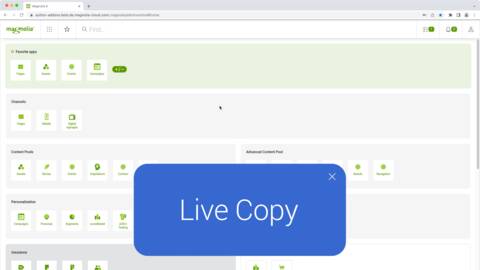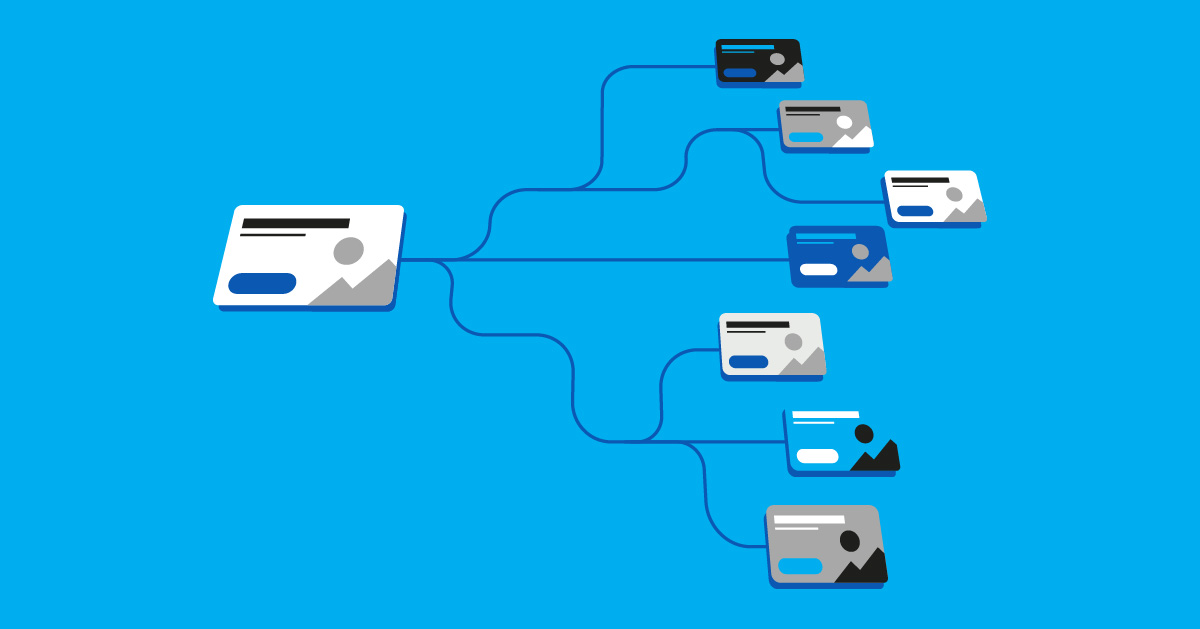- Juli 19, 2024
- 8 min
Executing a global content strategy with a DXP
Magnolia in Aktion
Unser Expertenteam zeigt Ihnen live, was Magnolia für Sie leisten kann.
Jetzt Demo buchenThe aim of the global content strategy is to attract, engage, and retain customers across different cultures, languages, and countries. A digital experience platform (DXP) doesn’t only provide global content management capabilities, allowing teams to streamline content creation and distribution, but with Magnolia’s connector packs, it also helps integrate with marketing automation tools, analytics, and more.
Prior to developing a global content strategy, brands should address several critical questions regarding their audience and how to distribute content across various customer touchpoints. These touchpoints can include mobile apps, native applications, social media platforms, IoT devices, and AI-powered conversational interfaces.
Learn more about Magnolia’s Live Copy feature from our video walkthrough. The tool helps you manage multiple sites that share content without duplicating efforts.
When customers make purchases today, they do so knowing that there is a wealth of information at their fingertips. The sheer number of digital devices, media platforms, and social networks available means that customers have access to volumes of content they can use to make their decisions.
In fact, customers today tend to do more research before buying anything, whether they want to be educated or entertained. This leads to increasingly complex journeys. According to Google, 60% of consumers are taking six or more actions to decide to buy a brand or product that’s new to them. 75% of these consumers search online for information and reviews, and 67% of them visit the brand’s website.
Consequently, content needs to be strategically managed from creation to distribution for actual effectiveness, and many enterprise companies need to do this on a global scale.
To serve a global audience, brands also need to have adequate systems in place for translation and localization of the content they produce. Google’s Consumer Insights reveal that for ecommerce clients, the ability to find information in their native language can be even more significant than a good price.
What is a global content strategy?
A content strategy is a process for planning, creating, delivering, maintaining, and managing content. For a global content strategy, it also includes executing at scale and for a worldwide audience.
But that’s not all. Content on the global stage needs a plan for the translation, localization, and management of this content. Also, brands need to decide how this content will be distributed and managed across multiple sites for each region.
A global content strategy can be complicated, but for many multinational companies, it is a necessity. While content may resonate well with a brand’s central region, the same content might not have the desired effect elsewhere. Companies strive to have a unified message that indicates the general message that the brand wants to convey, but it is also essential to consider the customer experience.
Customers who speak different languages or are part of a different culture may not resonate with the brand message in the same way. With a global content strategy, brands can account for these differences and develop plans to work with them.
Making your content strategy work
Before executing a global content strategy, there are a few factors which need to be considered. Ask yourself and your team these questions.
Who is your audience?
Brands need to ask specific questions before developing their content strategy. Such as where their audience is located. What languages do they speak? What cultural things are important to them? What is viewed as acceptable in one country but won’t resonate with audiences in another?
Customers want to engage and interact with a brand using their preferred language. So, understanding how to produce content for different audiences can improve the overall customer experience for those in other countries or those who don’t speak the company’s primary language. Even though a brand may serve an ideal customer, little nuances will vary for each of them. These nuances can make or break your content if they aren’t addressed.
For example, in one culture, the benefits of a particular product could be the main driver of sales. In another, that same product may need to be presented as evoking a specific emotion. Other factors, such as seasons, cultural holidays, and more, play a part in how a global audience receives content, and brands need to be aware of these differences.
Is your content team globally distributed?
Next, brands need to consider the makeup and distribution of their global teams. Content localization efforts can’t just be limited to translating one successful piece of content and then distributing it globally. Multiple people are often involved in the process of getting content ready for a global audience, and brands need the appropriate workflows and communication channels set up to assist them.
How will you manage content?
Finally, companies need to decide how their content will be managed. Creating and managing content for multiple platforms and regions can be a challenging thing to execute. Brands need access to the right tools that can help them manage their content, distribute to various channels and still coordinate with everyone on the team.
How much of your content is shared?
Some brands or products may have the exact same content across different countries or locales, and the only need is to translate. In some cases, a significant percentage of the content is shared - but not all, and in some other cases, you may not share much content across your websites, but you want to reuse some of the content (such as boilerplates or campaign content), or have variations of content for different audiences (the case of personalization). All these requirements are important as they will determine the types of tools and features you will need.
How a DXP helps your content strategy
A digital experience platform doesn’t only store content and distribute it to multiple locations; it also plays a vital role in the overall customer experience and helps content creators manage these experiences effectively. These are some of the features of a DXP that aid your content strategy.
Read More: What is a DXP?
Straight-talking DXPs
A straight-talking guide to digital experience platforms.
Omnichannel content production at scale
Customers today desire an omnichannel experience from their favorite brands. They want to be able to access content on one device and then maintain the same experience even when they switch to another. They want the content to be relevant and have the appropriate context for their needs. On a global scale, this becomes even more important. Brands need a global omnichannel marketing strategy and a way to produce content at scale to meet all of these requirements.
With a DXP, brands can distribute content to multiple channels through headless architecture. Not only the channels important today but emerging channels that haven’t been created yet. A DXP can provide the means to reach these channels as well as the user interface content teams require to customize and optimize content for each of these channels.
Multi-site localization
For brands with a global content strategy, it’s common to have multiple language-specific sites, as 40% of shoppers are reluctant to purchase from a website in another language. Statista’s survey also showed that 65% of global consumers prefer content in their language, even if it is poor quality.
Deep personalization
Customers actively engage with brands that effectively personalize content to address their specific needs, making them feel valued and unique. Personalization matters more than ever before as now consumers have endless options to choose from if they don’t like the experience they receive from one brand. McKinsey research shows that 71 percent of consumers expect companies to deliver personalized interactions. And 76 percent get frustrated when this doesn’t happen.
However, many brands can struggle with personalization. A DXP allows brands to personalize the customer experience for multiple individuals across multiple sites and channels and manage it all from a single platform.
Global content strategy with Magnolia
Magnolia’s digital experience platform has the hybrid headless architecture that makes content delivery to multiple channels and platforms simple. But content management is only one aspect of the global content strategy.
Magnolia’s connector packs make it easy to integrate with any content source, customer data, marketing automation tools, analytics and more to leverage the true power of a digital experience platform. Also, features such as Translation and Live Copy provide what brands need to deliver value to customers who speak different languages.

First off, Magnolia makes it easy to connect all content and data sources in one single UI. Assets from your DAM, products or catalogs from your Ecommerce system, forms from your marketing automation tool can be brought into the Magnolia UI as if they were native Magnolia content. With tagging and taxonomy, content can be organized into easily findable and reusable pools that can be mixed and matched to create pages and other experiences, in a fully visual editor.
Content is then delivered depending on context: user, language, country, device, application. Capabilities such as automatic translations, Live Copy feature to manage multiple sites that share content without duplicating efforts, campaign manager to reuse components or fragments of content such as banners, and personalization provide the right tools for each use case.
In particular, Live Copy is a powerful tool to manage multiple sites that share content without duplicating efforts. Live Copy allows you to quickly create live copies of a master site. The copies maintain a live relationship with the master site, which means they inherit content and properties from their original source. When you update content on your master site, you can flexibly enable or disable these changes across the live copies.
As a result, you can perform updates much faster and eliminate the error-prone manual work of copying similar pages to multiple locations across your websites.
Check it out and learn more in our video walkthrough below:









